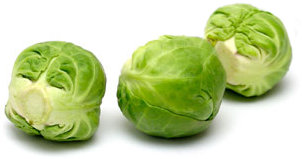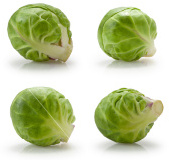

Brussels Sprouts

Brassica oleracea, Gemmifera Group. Cruciferae. A tall biennial grown for its small, cabbage-like, axillary buds. It has a loose head of large leaves which may also be harvested in a similar manner to cabbage. The crop is a derivative of the wild cabbage and, as its name implies, probably originated in Belgium, its cultivation starting in the Brussels region during the 19th century, whence it spread to other countries in Europe. It is grown widely in Britain but its importance is more limited outside Europe. In the United States it is grown mainly in California. Brussels sprout is a typical winter vegetable which can be harvested throughout the colder months of the year. Although highest yields are obtained in regions having cool summers and mild winters, the crop can stand moderately severe frost which, it is claimed, improves flavour. Late cultivars are particularly hardy and can withstand exposure to temperatures of –10ºC. In warm areas sprouts tend to grow loosely in contrast to the preferred tightly formed round buds. In warm wet climates the crop may be prone to infection by ringspot (Mycosphaerella brassicola), for which there is no effective control. Through appropriate choice of cultivars it is possible to harvest fresh sprouts from autumn until the following spring. After trimming and removing outer leaves the sprouts are cooked by boiling or steaming. Sprouts are also suitable for freezing. The head of the plant may also be boiled and used in a similar way to cabbage. The ideal soil is well-drained, medium to heavy, calcareous mineral soil. Lighter soils may suffer from drought during dry summers which can delay harvesting and reduce yields. Soil pH should be 6.5 or above and more acid soils should be limed. Organic soils are unsuitable as they tend to produce too leafy a plant and a high proportion of loose sprouts. Brussels sprouts, as with other brassicas, should not be grown on a site which has already been occupied by another brassica during the previous season. The land should be deeply cultivated in the autumn and, if available, well-rotted farmyard manure or garden compost should be incorporated into the soil. Although it is possible to establish the crop by direct sowing and thinning to a final stand, this is wasteful of land and transplanting is recommended. Bare-rooted transplants can be produced from a spring sowing in a finely produced tilth. For this purpose seeds may be sown thinly at a depth of 1-2cm in rows 15cm apart. Seedlings should be thinned at an early stage to give at least 3cm between plants, which should be ready for lifting when they reach a height of 10-15cm. Alternatively, pot-raised or modular-raised plants may be sown under glass during the winter and germinated at 10-13ºC. Plants raised under protection should be hardened off prior to transplanting to the permanent site in the spring. Final spacing should be 60 x 60cm square or wider for the late cultivars. Plants should be well watered in and irrigated in dry weather to maintain strong growth. Continuity of harvesting can be maintained by choice of cultivars and repeated plantings during the spring and early summer. 
It is possible to bring the harvest period forward and produce more evenly spaced sprouts by removing the plant’s main growing point. This is known as ‘stopping’ and should be carried out when the lower sprouts reach a diameter of just over 1cm. Late cultivars are unsuitable for stopping. Sprouts are snapped off by hand from the bottom of the stem upwards as they reach maturity. The large lower leaves should be removed from the plant as they senesce and turn yellow. Cultivars are now mainly F1 hybrids which produce more uniform sprouts and even maturity than the older open-pollinated types. A popular early hybrid for autumn harvesting is ‘Peer Gynt’, which is a medium-height to short plant producing medium-sized smooth solid sprouts; ‘Oliver’ is similar with large sprouts; ‘Jade Cross’ is higher yielding. Other recommended cultivars include ‘Dolmic’, ‘Pegasus’ and ‘Widgeon’, medium height, ‘Rampart’, tall, and ‘Peer Gynt’, dwarf. A succession of later cultivars to continue cropping through the winter could include ‘Mallard’, ‘Rampart’ and ‘Fortress’ (short). Other good overwintering cultivars are ‘Achilles F1’, ‘Bedford Fillbasket’, ‘Cambridge no.5’ (very late), ‘Croninger-Stiekema no.1’ and red-sprouted ‘Rubine Red’. Pests of Brussels sprout are common to most brassicas and include aphids, whitefly, cabbage root fly, flea beetles and the caterpillars of the cabbage white and other butterflies. Aphids can be difficult to detect as they can enter young buds at an early stage and remain hidden within the developing sprouts. Diseases include ringspot and club root.
|
Home
Grow Nuts
Grow Herbs
Grow Fruit
Cyberian Index
If you like this website and want one of your own contact
Cyberian All information correct at
time of publication and open to updates as necessary. No part of this website,
or its vectors, may be produced in any shape or form, using any type or design
of medium, system, equipment or otherwise without the prior written consensual
notice of the Cyberian. Any breach of these requirements will result in the
appropriate action. If in doubt, e-mail contact is recommended.
Some components of this website were obtained as open-source software and are
used in the same non-profit manner on this website.